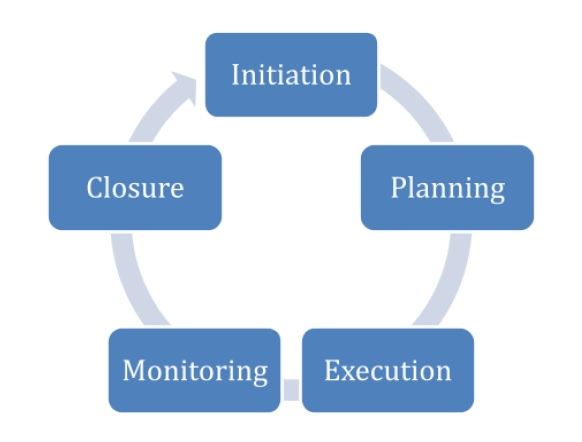
 Data Structure
Data Structure Networking
Networking RDBMS
RDBMS Operating System
Operating System Java
Java MS Excel
MS Excel iOS
iOS HTML
HTML CSS
CSS Android
Android Python
Python C Programming
C Programming C++
C++ C#
C# MongoDB
MongoDB MySQL
MySQL Javascript
Javascript PHP
PHP
- Selected Reading
- UPSC IAS Exams Notes
- Developer's Best Practices
- Questions and Answers
- Effective Resume Writing
- HR Interview Questions
- Computer Glossary
- Who is Who
What is Project Cycle Management?

Project cycle management is a process of planning and organizing a project. It is done with the help of project management principles. The main purpose of the project management cycle is to ensure there is a minimal error in the end product and that the process is aligned with the stakeholder's expectations. Each project has a lifecycle, marking the project's beginning and completion. There are several things that go into the project lifecycle.
The phases include project planning, project execution, and closure. These phases are further divided into several stages, and each requires a different set of tools. The goal is to divide large projects into small tasks that are manageable and can be monitored effortlessly. This makes it easy for the managers and the workforce to stay on budget and timeline. It also allows you to follow the instructions closely.
What is Project Cycle Management?
PCM was developed by experts who saw the need for an accurate method to finish the project. This was much-needed because people used to copy the project management methods implemented by other organizations, which was considered extremely inappropriate for all the right reasons. The methodology was adopted in 1992 by the European Commission, but its success made it popular worldwide.
As mentioned above, the main purpose of project cycle management is to align the project phases with the stakeholder's expectations and to address all sorts of challenges that might arise throughout the PCM phases. These are divided into six phases ? programming, identification, formulation, financing, implementation, and evaluation. People might use different names for each phase, and the process is also tweaked to deal with various organizational problems. Some entities only implement five steps instead of six. The main goal is to streamline project management and decision-making.
How Does Project Cycle Management Work?
PCM is implemented to improve the lifecycle of a project and ensure better results. As mentioned above, the project is broken down into various phases. It works like a chapter of a book. You have to proceed with another chapter only after finishing the current one. This way, it's easier to pay attention to each phase of the project and ensure that the quality standards are met. It also ensures that your project is completed following the stakeholder's instructions. Simply put, project cycle management is designed to help people accomplish any project within the given timeline without compromising on quality.
Once you have finished the first phase, you can move on to the other one. PCM consists of several components, including identifying risk factors, transparency, expectations, and the project's structure. Many organizations that have implemented the PCM have reported better and improved outcomes, organized procedures, and satisfied end-users.
Why Implement Project Cycle Management?
Handling a large project, especially the complex one, seems pretty difficult. Many professionals have mentioned their concerns about finishing the project in a timely manner and with accuracy. Completing a given project seems even more overwhelming when you have a history of similar projects that were left unfinished.
Here are the three important reasons why more and more businesses are considering project cycle management.
Simplicity ? Ask any project manager about working on a complex project, and they will most likely tell you simplicity is what they need to handle every project seamlessly. To achieve that simplicity, people implement the project management cycle. It's an easy and effective way to ensure that your project seems simple and achievable. Not only for the leaders but a project is broken down into several phases is easier to finish for the workforce.
Better Productivity ? It's not possible to manage a project without managing time. No matter how complex or simple the project is, everything comes down to how effectively you manage time and resources. Once you have implemented PCM, your team gets a clear picture of how to execute each phase, how much time they must dedicate to each process, and how to ensure productivity. A task that seems overwhelming at first glance quickly turns into "we can achieve it" when there are smaller steps to perform each day instead of finishing one large and complex project in a given timeframe. PCM improves employees' morale while ultimately boosting their productivity.
Transparency ? One of the biggest benefits of PCM is transparency, which also happens to be the major challenge in achieving success in any project. Communication is quite difficult when it comes to complex projects. That's what the PCM helps to resolve. The leader or manager communicates each phase clearly to the workforce, explaining every aspect of the project concisely. Even if they don't explain everything verbally, the phases are quite easy to interpret. Once the project details are explained well, the goals can be achieved easily.
Main Phases of a Project Cycle Management
Projects become complex when you are working with a team, have a strict deadline to achieve, and are faced with economic challenges. PCM doesn't guarantee success, but it makes your project manageable by breaking down a large project into smaller and achievable steps. Here are the crucial phases of project cycle management.

Initiation ? The first stage is identifying a project's idea and scope. During this phase, the team decides which areas will require more attention, the resources required throughout the project, and more.
Planning ? A strong plan is something that minimizes the risks in the project and guides the workforce toward success.
Execution ? This is where all the hard work is done. Execution refers to bringing all ideas into reality by working on each phase established during the planning phase. Everything is already clarified in detail, and you only need to execute those steps.
Monitoring ? Not everything will go as you have planned. It's better if it does, but if not, you must have a backup plan ready to ensure your goals are met within the established timeframe.
Closure ? Once the execution and monitoring are over, the final product is delivered to the client. Closure of the project is the final step, where you get feedback from the end user. Based on that, you decide whether you need to make improvements.

